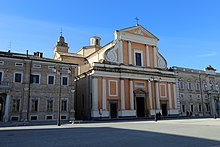Senigallia Cathedral
The Cathedral of Senigallia or the Cathedral of the Apostle St. Peter ( Italian Cattedrale di San Pietro apostolo ) is the cathedral of Senigallia and the diocese of the same name in the Italian region of Marche . The church from the end of the 18th century is dedicated to the Apostle Peter and has the title of a minor basilica .
history
The current cathedral, the fifth episcopal church of the diocese, was built according to plans by the architect Paolo Posi on top of an existing Jesuit church. After construction between 1762 and 1790, the consecration took place on July 4th. In 1838 the Chapel of Mary of Hope was completed. The facade dates from the second half of the 19th century and was designed by Pope Pius IX. , originally from Senigallia, commissioned and financed by Augusto Innocenti according to a project. After several earthquakes, the church had to be restored several times, such as those of 1836 and 1930. After renovations in 1931 with new frescoes by Giovanni Marchini, among others, Pope Pius XI. the cathedral became a minor basilica in 1932. After the last major earthquake in 1997, the cathedral had to be closed for five years.
description
The three-aisled basilica has a cruciform floor plan, above which the crossing dome rises. The elliptical chapel of Mary of Hope , designed by the architect Giuseppe Ferroni, is surrounded by eight columns with Corinthian capitals in Sicilian jasper and with bases in yellow marble, while inside is presented the Madonna of Hope, a copy or restoration of a canvas from 1578 by Ercole Ramazzani. The facade in the classical style has two storeys one above the other, Doric in the lower part, Ionic in the upper part.
The important church furnishings include works of Italian Mannerism by Federico Barocci (Rest on the Flight into Egypt), Ercole Ramazzani (Madonna of Hope), Domenico Corvi (St. Paulino and St. Maria Magdalena) and Alessandro Tiarini (Assumption). In the main nave there is a large bronze statue of Pius IX.
In the sacristy is a 6th century sarcophagus known as the sarcophagus of St. Gaudentius ; the symbols of the evangelists are depicted on the corners of its lid . Bishop Sigismondo is said to have kept the relics of St. Gaudentius there from 590, which were later stolen in 1520 and brought to Ostra .
The organ stands on the right side of the chancel . The work by Carlo Vegezzi Bossi from 1906 has two manuals and 20 stops.
Web links
Individual evidence
- ↑ a b Basilica Cattedrale di S. Pietro Apostolo on gcatholic.org (English)
- ↑ Chiesa di San Pietro Apostolo on beweb.chiesacattolica.it (Italian)
Coordinates: 43 ° 42 ′ 50 " N , 13 ° 12 ′ 54.7" E
